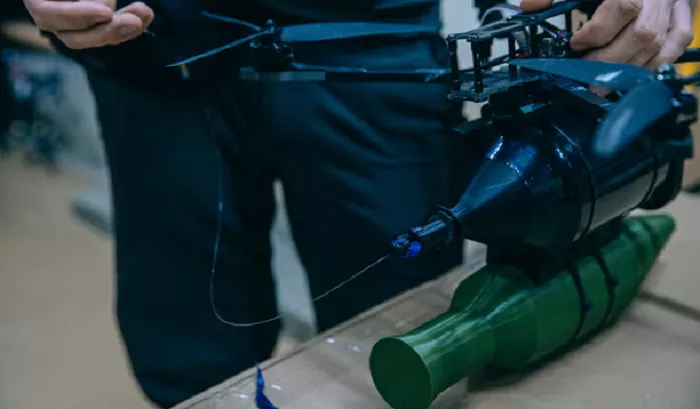On the battlefields of Ukraine, new and unexpected threats are emerging. Thread-like filaments of wire stretched across fields and netting rigged between trees are signs of a new weapon on the frontlines—fibre optic drones. These high-tech yet low-tech devices, designed to bypass conventional jamming systems, are becoming a key tool in modern warfare.
In a secret workshop in northeastern Ukraine, about 20 workers are assembling hundreds of these drones. The design is familiar: a quadcopter, but with a twist. Beneath the frame is a cylindrical housing containing a coiled fibre optic cable, extending up to 20 kilometers (12 miles). This makes them “wired kamikaze drones”—capable of flying undetected and avoiding jamming.
Capt. Yuriy Fedorenko, commander of Ukraine’s Achilles regiment, which specializes in drones, explains that fibre optic drones were developed in response to the growing threat of electronic warfare. These drones are resistant to jamming because they lack a radio connection. They can fly low through forests and between tree lines—areas where traditional FPV (first person view) drones might lose signal. These drones have successfully navigated areas previously thought to be safe, such as tree-lined supply roads.
A video circulating on Russian military Telegram channels last month demonstrated the capability of these drones. The footage showed a fibre optic drone flying just above the ground, striking a Ukrainian howitzer hidden in a barn—proving that even the most concealed positions are vulnerable to this new technology.
Combat medic Oleksii, stationed in Pokrovsk, the busiest front in Ukraine’s east, describes how fibre optic drones have made evacuations nearly impossible. “It’s just not happening now that there are fibre optic drones. They cannot be jammed and for now, they are the main concern for the guys on the frontline,” he says.
However, while Ukraine is catching up, Russia has had a head start. Moscow has had easier access to fibre optic cables, which helped them lead the way in developing these drones. Russian forces used them extensively during their counteroffensive in Kursk, which analysts believe was instrumental in their success. According to experts, drones now account for 70% to 80% of military casualties on both sides. Fibre optic drones are especially useful in the early stages of an assault, where they target enemy jamming and electronic warfare capabilities. This clears the way for other drones to strike more effectively.
At the Achilles regiment’s workshop, the cost of producing a fibre optic drone is higher than conventional FPV drones. While a standard FPV drone costs about $400, adding the fibre optic cable adds another $400. The cables are delicate and sensitive to damage, and the drones themselves require specialized training to fly, with operators experiencing a high failure rate during practice. Yet, with thousands of drone pilots now on both sides of the battlefield, there is a growing pool of skilled operators willing to learn.
Fibre optic drones are becoming increasingly important, with about 10% of the workshop’s production dedicated to them. Ukrainian President Volodymyr Zelenskyy recently discussed the growing role of these drones with military leaders, highlighting that more than 20 new certified drone models with fibre optic control systems have been introduced this year alone. Eleven Ukrainian enterprises have already mastered their production, signaling the country’s growing self-sufficiency in drone technology.
General Oleksandr Syrskyi, Ukraine’s chief military commander, reported that drones have helped destroy over 77,000 enemy targets this year, with fibre optic drones achieving a kill range of up to 20 kilometers. This reflects how the modern battlefield has extended far beyond the traditional trench lines.
In a notable recent strike, Ukrainian drones targeted a Russian fibre optic factory in Saransk, about 400 miles from the border. This attack raises questions about the vulnerability of the fibre optic supply chain and whether similar strikes could disrupt enemy drone operations.
Efforts to counter these drones are also emerging. Netting, designed to entangle the drones and their cables, is becoming more common, and Ukrainian forces are exploring ways to sever or destroy the fibre optic cables. Fedorenko, however, cautions that while the cables are tough, solutions to counter them are being developed.
The use of fibre optic drones marks a new chapter in the ongoing conflict, combining cutting-edge technology with innovative tactics to change the nature of warfare.


